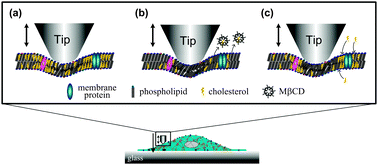Characterization of cholesterol-depleted or -restored cell membranes by depth-sensing nano-indentation†
Abstract

* Corresponding authors
a
Department of Materials Science and Engineering, National Cheng Kung University, Tainan, Taiwan
E-mail:
jdliao@mail.ncku.edu.tw
b Innovation Center for Advanced Medical Device Technology, National Cheng Kung University, Tainan, Taiwan
c
Department of Neurology, National Cheng Kung University Hospital, Tainan, Taiwan
E-mail:
cxl45@mail.ncku.edu.tw
d Department of Mechanical Engineering, National Cheng Kung University, Tainan, Taiwan
e Department of Computer Science and Information Engineering, National Cheng Kung University, Tainan, Taiwan

 Please wait while we load your content...
Something went wrong. Try again?
Please wait while we load your content...
Something went wrong. Try again?
Y. Yang, J. Liao, C. K. Lin, C. Chang, S. Wang and M. Ju, Soft Matter, 2012, 8, 682 DOI: 10.1039/C1SM06180A
To request permission to reproduce material from this article, please go to the Copyright Clearance Center request page.
If you are an author contributing to an RSC publication, you do not need to request permission provided correct acknowledgement is given.
If you are the author of this article, you do not need to request permission to reproduce figures and diagrams provided correct acknowledgement is given. If you want to reproduce the whole article in a third-party publication (excluding your thesis/dissertation for which permission is not required) please go to the Copyright Clearance Center request page.
Read more about how to correctly acknowledge RSC content.
 Fetching data from CrossRef.
Fetching data from CrossRef.
This may take some time to load.
Loading related content
